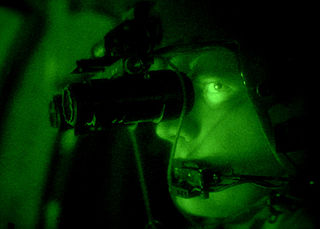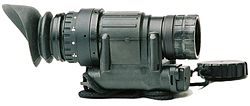
Single Channel Ground and Airborne Radio System (SINCGARS) is a very high frequency combat-net radio (CNR) used by U.S. and allied military forces. In the CNR network, the SINCGARS’ primary role is voice transmission between surface and airborne command and control assets.

Night vision is the ability to see in low-light conditions, either naturally with scotopic vision or through a night-vision device. Night vision requires both sufficient spectral range and sufficient intensity range. Humans have poor night vision compared to many animals such as cats, dogs, foxes and rabbits, in part because the human eye lacks a tapetum lucidum, tissue behind the retina that reflects light back through the retina thus increasing the light available to the photoreceptors.

A night-vision device (NVD), also known as a night optical/observation device (NOD), night-vision goggle (NVG), is an optoelectronic device that allows visualization of images in low levels of light, improving the user's night vision. The device enhances ambient visible light and converts near-infrared light into visible light which can be seen by the user; this is known as I2 (image intensification). By comparison, viewing of infrared thermal radiation is referred to as thermal imaging and operates in a different section of the infrared spectrum. A night vision device usually consists of an image intensifier tube, a protective housing, and may have some type of mounting system. Many NVDs also include a protective sacrificial lens, mounted over the front lens (ie. objective lens) on NVDs to protect the latter from damage by environmental hazards and some can incorporate telescopic lenses. The image produced by an NVD is typically monochrome green, as green was considered to be the easiest color to look at for prolonged periods in the dark. Night vision devices may be passive, relying solely on ambient light, or may be active, using an IR (infrared) illuminator to visualize the environment better.
Harris Corporation was an American technology company, defense contractor, and information technology services provider that produced wireless equipment, tactical radios, electronic systems, night vision equipment and both terrestrial and spaceborne antennas for use in the government, defense and commercial sectors. They specialized in surveillance solutions, microwave weaponry, and electronic warfare. In 2019, it merged with L3 Technologies to form L3Harris Technologies.

The Modular Integrated Communications Helmet (MICH) is a U.S. combat helmet and one of several used by the U.S. military. It was developed by the United States Army Soldier Systems Center to be the next generation of protective combat helmets for use by the U.S. Army.
The Special Operations Peculiar MODification (SOPMOD) kit is an accessory system for the M4A1 carbine, CQBR, FN SCAR Mk 16/17, HK416 and other weapons used by United States Special Operations Command (USSOCOM) special forces units, though it is not specific to SOCOM. The kit allows US Special Operations Forces personnel to configure their weapons to individual preferences and customize for different mission requirements.

Pupillary distance (PD), more correctly known as interpupillary distance (IPD) is the distance in millimeters between the centers of each pupil.

The Lightweight Helmet (LWH), also known as the Lightweight Marine Corps Helmet or Lightweight Marine Helmet, is an armored helmet that is used by the United States Marine Corps and U.S. Navy. It is the U.S. Marine Corps' replacement for the PASGT combat helmet and is derived from the Modular Integrated Communications Helmet.

The CG634 is the Canadian Armed Forces' main combat helmet. It was introduced in 1997 and is based on the French Gallet TC-3 helmet. The helmet has protection equal to an NIJ Level 3a rating, being able to stop a shot from a .357 Magnum.

AN/PVS-4 is the U.S. military designation for a specification of the first second generation passive Night vision device.
NV5 Geospatial Solutions develops products for the visualization, analysis, and management of geospatial imagery and scientific data. The company develops products such as IDL, ENVI, Jagwire, and Helios which are used in a variety of industries including defense and intelligence, environmental, engineering, aerospace, medical imaging, federal and civil governments, precision agriculture and academia worldwide.

The AN/PSQ-20 Enhanced Night Vision Goggle (ENVG) is a third-generation passive monocular night vision device developed for the United States Armed Forces by ITT Exelis. It fuses image-intensifying and thermal-imaging technologies, enabling vision in conditions with very little light. The two methods can be used simultaneously or individually. The ENVG was selected by the US Army's Program Executive Office Soldier as a supporting device for the Future Force Warrior program in 2004, and is intended to replace the older AN/PVS-7 and AN/PVS-14 systems. Although more expensive and heavier than previous models, US Special Forces began using the goggles in 2008 and the US Army's 10th Mountain Division began fielding the AN/PSQ-20 in 2009. Improvements to the goggles have been attempted to make them lighter, as well as enabling the transmission of digital images to and from the battlefield.
Exelis Inc., was a global aerospace, defense, information and services company created in October 2011 as a result of the spinoff of ITT Corporation's defense business into an independent, publicly traded company. The company was headquartered in Tysons Corner, Virginia, USA and was led by CEO and President David F. Melcher. The Washington Post highlighted Exelis as a top company in the Washington, D.C. region in 2011. It was acquired by the Harris Corporation for $4.75 billion in 2015.

The AN/PVS-7 is a single tube biocular night vision device. Third-generation image intensifiers are able to be installed and are standard for military night vision. Most newer PVS-7 intensifier tubes are auto-gated to prevent image intensifier damage if exposed to intense light. The goggles have a built-in infrared Illuminator for low-light situations. They are waterproof and charged with nitrogen to prevent internal condensation while moving between extreme temperatures.

Ratnik is a Russian future infantry combat system. Some components, including the communication systems and night vision technologies, have extremely limited military distribution. It is designed to improve the connectivity and combat effectiveness of combat personnel in the Russian Armed Forces. Improvements include modernised body armour, a helmet with a special eye monitor, communication systems, and special headphones. It includes 10 subsystems and 59 individual items.

The AN/PVS-17 Miniature Night Sight (MNS) is a compact, lightweight and high performance night vision weapon sight in wide use by the United States Special Forces and United States Marine Corps (USMC). The AN/PVS-17 is a Generation III Night Vision Device and uses the OMNI IV MX 10160 3rd generation image intensifier tube and can also be used as a handheld observation device. The designation AN/PVS translates to Army/Navy Portable Visual Search, according to Joint Electronics Type Designation System guidelines.
L3Harris Technologies, Inc. is an American technology company, defense contractor, and information technology services provider that produces command and control systems and products, wireless equipment, tactical radios, avionics and electronic systems, night vision equipment, and both terrestrial and spaceborne antennas for use in the government, defense, and commercial sectors.

The AN/PSQ-42 Enhanced Night Vision Goggle-Binocular (ENVG-B) is a third-generation passive binocular night vision device developed for the United States Army by L3Harris. It combines dual tube image-intensifying (I²) and thermal-imaging technologies into a single goggle, enabling vision in low-light conditions. The two methods can be used individually or simultaneously in a fused mode. The ENVG-B is intended to be issued to the dismounted combat arms soldiers within the Army's Brigade combat teams (BCT), and so far over 10,000 have been issued to several BCT's within the 1st Infantry Division, 2nd Infantry Division, 25th Infantry Division, 82nd Airborne Division and 101st Airborne Division. The US Marine Corps has also purchased 3,100 ENVG-B units.













